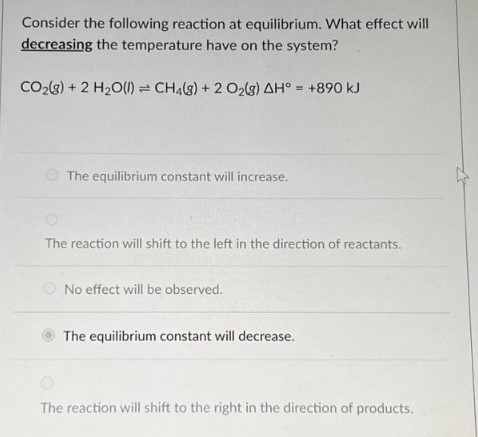QQuestionAnatomy and Physiology
QuestionAnatomy and Physiology
Consider the following reaction at equilibrium. What effect will decreasing the temperature have on the system?
\mathrm{CO}_{2}(g)+ 2 \mathrm{H}_{2} \mathrm{O}(l) \rightleftharpoons \mathrm{CH}_{4}(g)+ 2 \mathrm{O}_{2}(g) \Delta \mathrm{H}^{\circ}=+ 890 \mathrm{~kJ}
The equilibrium constant will increase.
The reaction will shift to the left in the direction of reactants.
No effect will be observed.
The equilibrium constant will decrease.
The reaction will shift to the right in the direction of products.
Attachments

6 months agoReport content
Answer
Full Solution Locked
Sign in to view the complete step-by-step solution and unlock all study resources.
Step 1: Understand the problem and recall the effect of temperature on chemical equilibrium.
When the temperature of a system at chemical equilibrium is changed, the position of equilibrium shifts to counteract the temperature change. This is described by Le Chatelier's principle. If the reaction is exothermic (releasing heat, as indicated by a positive ΔH°), increasing the temperature will favor the endothermic direction (reactants), and the equilibrium will shift to the left. Conversely, decreasing the temperature will favor the exothermic direction (products), and the equilibrium will shift to the right.
Step 2: Identify the reaction type and temperature change.
The given reaction is exothermic (ΔH° = + 890 kJ), and the temperature is decreased.
Final Answer
The reaction will shift to the right in the direction of products.
Need Help with Homework?
Stuck on a difficult problem? We've got you covered:
- Post your question or upload an image
- Get instant step-by-step solutions
- Learn from our AI and community of students